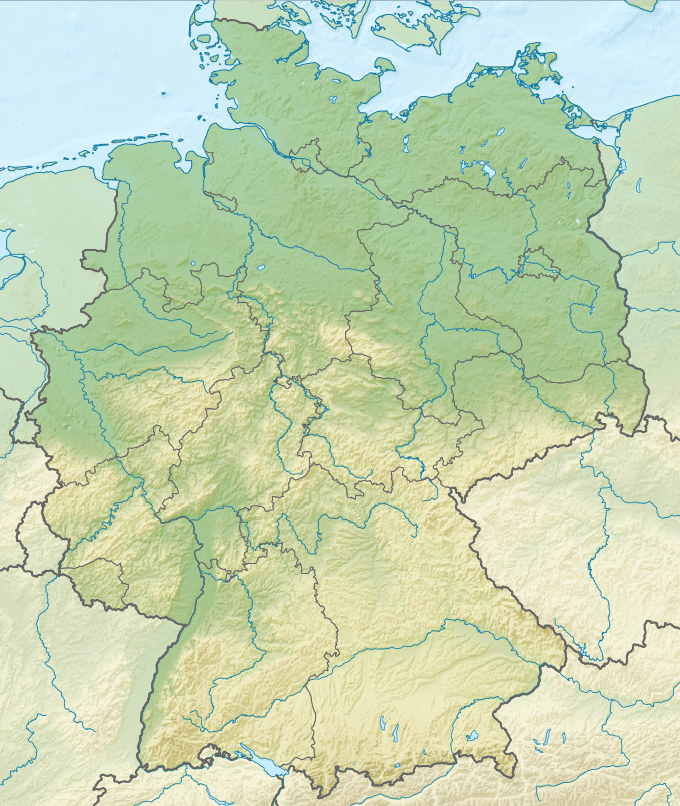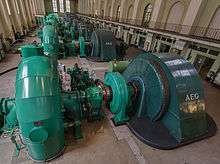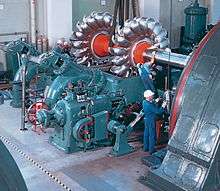Walchensee Hydroelectric Power Station
| Walchensee power station | |
|---|---|
 | |
 Location of Walchensee power station in Germany | |
| Country | Germany |
| Location | Walchensee, Kochel |
| Coordinates | 47°37′54″N 11°20′15″E / 47.63167°N 11.33750°ECoordinates: 47°37′54″N 11°20′15″E / 47.63167°N 11.33750°E |
| Status | Operating |
| Commission date | 1924 |
| Owner(s) | E.ON |
| Thermal power station | |
| Primary fuel | Hydro |

The Walchensee Power Plant (German: Walchenseekraftwerk) is a hydroelectric power station in Bavaria Germany. It is a storage power station that is fed water from the Walchensee Lake which is then released into the Kochelsee Lake. The original installed output was 124 MW. The power plant is located south of Kochelsee, about 14 kilometres (8.7 mi) from the village of Walchensee, and generated 300 MW as of 2010. It is one of the largest of its kind in Germany.[1]

Technical operation
The power station uses the hydraulic head of about 200 metres (660 ft) between the Walchensee (acting as the upper reservoir, at 802 metres/2,631 ft above sea level) and the Kochelsee (599 metres/1,965 ft a.s.l.) to generate electricity.[2] Through six, 450-metre (1,480 ft) ducts connecting the two natural lakes, the water flows to the hydro-electric plant's four Pelton water turbines with single-phase generators, and four Francis water turbines with three-phase generators, and then exits into the Kochelsee.[3] Because the water level constantly changes, neither lake fully freezes in the winter; what does freeze on the lakes is potentially hazardous thin ice. The natural outflow of the Walchensee at Niedernach — over the Jachen to the River Isar — is blocked by a weir, but the natural inflow to the lake is still insufficient to provide enough water to the reservoir for the operation of the power station, so the waters of the Rißbach river are also used.
Isar transfer
The Isar, which flows as a whitewater river from the Austrian part of the Karwendel mountains, is dammed between Mittenwald and Krün by a weir to form the Krüner Isar reservoir (870 metres/2,850 ft) and is then diverted to the Walchensee. This water flows past the Krün hydroelectric plant in an open channel, through a culvert, under the B 11 road at Wallgau and then via a tunnel to the Sachensee lake (867 metres/2,844 ft). Here a 3.9 kilometer long penstock begins. At the end the water enters the hydro-electric power plant at (795 metres/2,608 ft), propels the turbines, and finally flows into the lake.
Rißbach transfer
The Rißbach comes from the northern part of the Karwendel mountains, where it gathers the water of smaller streams in the Ahornboden area. After crossing the border between Tirol and Bavaria, and immediately after the inlet of the Fermersbach, a 6960 m lug carries water to the hydro-electric power plant at Niedernach at the southeast end of the Walchensees. The power station has been in operation since 1951.
Distinctive features
The main road from the village of Walchensee to Urfeld runs below the steep slopes of the Herzogstand. Construction had to withstand the pressure exerted by the Walchensee on the embankment, so that the road did not slide away. If the water level in winter falls due to outflow through the Walchensee power station, use of the road by trucks is limited by weight restrictions. In spring plant operators are obligated to increase the water level again in such a way that traffic restrictions — primarily affecting tourism — can be lifted or penalties are imposed. During winter operators must monitor the snow accumulated in the catchment area to calculate the amount of melt water expected and to comply with water level requirements. The Walchensee, along with other Bavarian power stations in the region, produce 236 megawatts of power, translating to 1.3 billion kilowatt hours of clean energy to almost 400,000 Bavarian households as of 2010.[1]
History
Oskar von Miller was the developer and designer of the Walchensee power station. He supported the electrification of the Bavarian railways (see also Mittenwald Railway) and the development of Bavaria. After lengthy preliminary work, the Bavarian parliament agreed to the construction of the power plant in 1918. Construction began in December 1918 and in 1924 the plant began producing electrical power. The problem of transporting that power over long distances was solved with the introduction of overhead power lines.[4] From the outset, demand for power was so great that hydroelectricity could only provide a third of the required output, with the balance being supplied by traction engines. The plant was originally owned by the state-owned Bayernwerk AG (Bavarian Works Company). Bayernwerk was later denationalised and taken over by VIAG (Vereinigte Industrieunternehmungen) and as a result the power station is now operated by E.ON Wasserkraft GmbH.
World War II wind tunnel
To develop Nazi Germany's planned A10 rocket, a new Mach 10 wind tunnel was planned at the power station. The new power plant was to use the 202 meter difference from the Walchensee down to the Kochelsee to generate 120 megawatts. However, instead of a new wind tunnel and power plant, the Mach 4.4 wind tunnel used for V-2 rocket development was moved to the site following the 1943 Operation Hydra bombing of Peenemünde, and the new powerplant was completed after the war.[5] The wind tunnel was moved to White Oak, Maryland, after the war.[6]
Notes
- 1 2 http://apps.eon.com/documents/EWK_Walchensee_2010_ger.pdf
- ↑ http://www.oberland.de/Woher-kommt-eigentlich-das-Isa.253.0.html
- ↑ "The Walchensee Power Plant. A Technological Jewel in the Alps." (PDF). e.on Wesserkraft. Retrieved 21 September 2013.
- ↑ http://www.environmentandsociety.org/mml/walchensee-hydroelectric-power-station-dennis-gaertner
- ↑ Wegener, Peter P (1996). The Peenemunde Wind Tunnels: A Memoir. Yale University. p. 32. ISBN 0-300-06367-9.
- ↑ Hunt, Linda (1991). Secret Agenda: The United States Government, Nazi Scientists, and Project Paperclip, 1945 to 1990. New York: St.Martin's Press. p. 31. ISBN 0-312-05510-2.
External links
| Wikimedia Commons has media related to Walchensee Hydroelectric Power Station. |